
|
 |

|
 |
An imaginary interview with Guru Gopinath - Part 10 - Tapati Chowdhurie e-mail: tapatichow@yahoo.co.in Photos courtesy: Sashimohan April 20, 2022 All parts of the interview The story so far In the previous chapter, Guru Gopinath spoke at length about his trip to Russia as a member of the cultural delegation sent by Pandit Nehru in 1955. He also spoke about his participation in the All India Dance Seminar held in New Delhi in 1958 along with his repertory group. To mark the occasion, Pt Jawaharlal Nehru had hosted a tea party in Teenmurthi Bhavan, where Guruji was invited. Panditji greeted film actor Devika Rani and her husband, the famous Russian painter Svetoslav Roerich and led them to a place where they would drink tea together. The 10th part of the imaginary interview 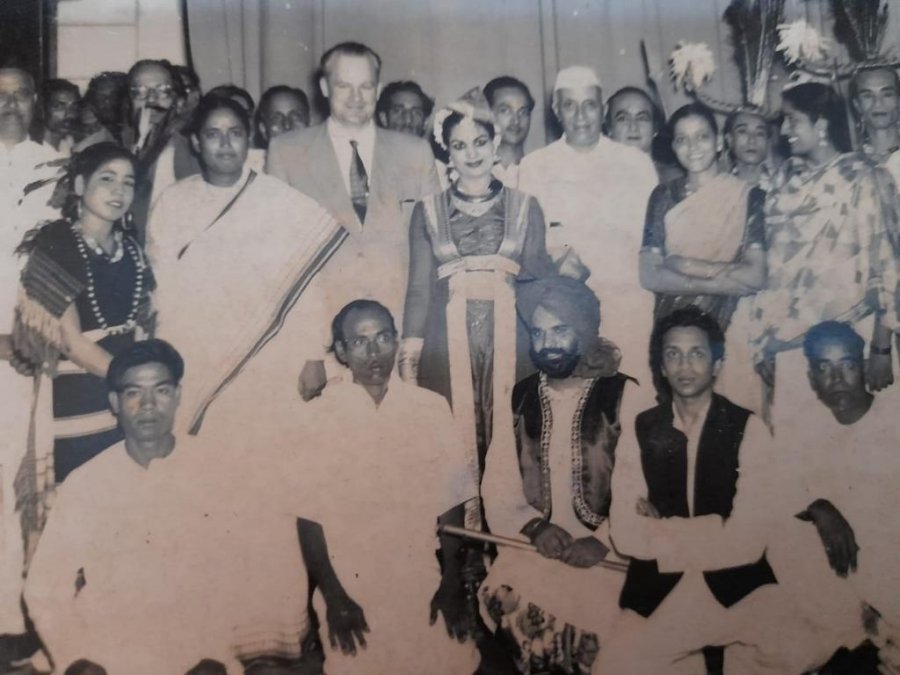 Guru Gopinath and group with Pt Nehru Pt Nehru invited you to a tea party at Teenmurthi Bhavan when you were in New Delhi for the All India Dance Seminar in 1958. What do you remember about your memorable interaction with Pt Jawaharlal Nehru, the first Prime Minister of India? I was a little hesitant when Panditji came, shook my hand and said "Aao, Aao" and offered me a cup of tea. I could hear non-stop clicking of cameras and flashing of lights. I was at the top of the world. I am being photographed having tea with Pt Nehru? After having tea, I mustered up courage enough to request Panditji as politely as I could, if I could get his autograph. He was more than happy to oblige. He signed in a small diary and handed it over to me, patting me on my shoulders gently. That was the first time in my life I had ever taken an autograph signature from anyone. After all, was he not the Indian Prime Minister, whose signature I had taken?! What did you experience at the dinner party in Amritsar? What opinion did you form about E.M.S. Namboodripad, the Communist Party Chief Minister of Kerala? After the dance seminar, on the invitation of P.C. Joshi, a leading Communist Party worker, my troupe and I performed on two occasions at the Communist conference in Amritsar. At that conference, the then Chief Minister of Kerala, E.M.S. Namboodripad was also there. After the second session, P.C. Joshi invited me to a dinner party, which was also attended by the Chief Minister. Remembering the dinner at Bolshoi theatre, I wore my formal long coat, breeches and shoes and reached the venue. But Joshi came and took me to a tent. He asked me to remove my shoes before entering the tent and I did accordingly. On entering, I saw E.M.S. Namboodripad and other communist leaders sitting on a grassy lawn, eating chappatis and potato curry. I bowed to everyone especially E.M.S. Namboodripad, who welcomed me and asked me to sit down and join the others to eat. The meal was served on banana leaf. After sometime they served rice and dal. I had that too. In the end, we were served rasagullas as dessert. The Chief Minister preferred to stay with the party workers in a tent even though he was invited as a guest by the Punjab Government and was entitled to their excellent hospitality in an upmarket hotel. I have never seen such a self-sacrificing politician in my life. What kind of program did E.M.S. Namboodripad want you to present? From Amritsar, I returned to Delhi with the party. I stayed in the outhouse of Kerala house. The next day, I visited E.M.S. Namboodripad, when he came to Kerala House. He suggested that I should direct a dance program that can be enjoyed by both the Malayalees and non-Malayalees. His opinion was that the program held in Amritsar was more classical. I convinced him that I would try to present a program to his specification. 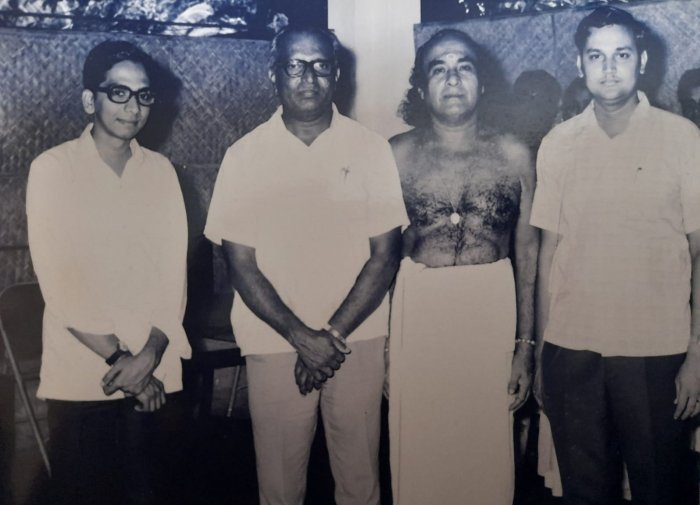 With SNA team from Delhi. Govind Vidyarthi is 2nd from left What offer did you get from Sumitra Charat Ram and Nirmala Joshi? Sumitra Charat Ram (the secretary of Bharatiya Kala Kendra, Delhi) and Nirmala Joshi (Secretary, Kendra Sangeet Natak Akademi) requested me to be the Director of the Ramayana ballet that they used to hold during Navaratri in New Delhi. I accepted the job. In 1959, I handed over the responsibility of Natana Niketan to Thangamani and moved to Delhi and joined my new job. There were 48 artistes (both male and female) from different places in that ballet troupe. The drama was based on Tulsidas' Ramacharitmanas. It was a 3 hour long dance drama with 75 scenes from the battle of Devasura till the crowning ceremony of Lord Rama. The classical dances of India like Manipuri, Kathak, Bharatanatyam, Kathakali and the folk dances were used in the dance drama as the situation demanded. This ballet was directed by Narendra Sharma in 1957 and by the brother of Uday Shankar, Devendra Shankar in 1958. In 1959, when I took over the responsibility of directing this ballet, I wasn't very fluent in the Hindi language. I ordered the book 'Tulasidas' Ramayana' of Kavungal Neelakantha Pillai and studied the Hindi words and its meaning and memorized them. Accordingly, I coordinated the mudras, gestures, facial expressions and adapted them to suit the characters and the plot. The actors were taught to adapt themselves to suit the context without compromising on the character, story and the sthayi bhava. Ragam - thalam - melam (music) was also adapted accordingly. Some necessary changes in the costumes had to be made. I completed the direction of that ballet in about 4 months. I tried to include some heartwarming ideas from the Russian ballet that I saw during my trip to the Soviet Union in the Ramayana dance drama. Especially, I used lights that would not fade out the costume colours of the characters. Ram Leela was usually performed during Navaratri in Ferozshah Kotla ground for a month. Apparently in the previous productions in 1957 and 1958 Bharatiya Kala Kendra had suffered huge losses. The year when I directed Ram Leela, it was performed daily for one and a half months instead of one month and Bharatiya Kala Kendra earned a profit of one lakh rupees. How did the press respond to the presentation of Ram Leela under your direction? The very next day after the first presentation of Ram Leela, well known newspapers like The Statesman, Hindustan Times and Times of India wrote glowingly about the performance of the main characters and my direction. That year, luminaries like Dr. Rajendra Prasad, Dr. Radhakrishnan, Pt. Jawaharlal Nehru, Lal Bahadur Shastri and Indira Gandhi happened to see the Ramayana presentation. 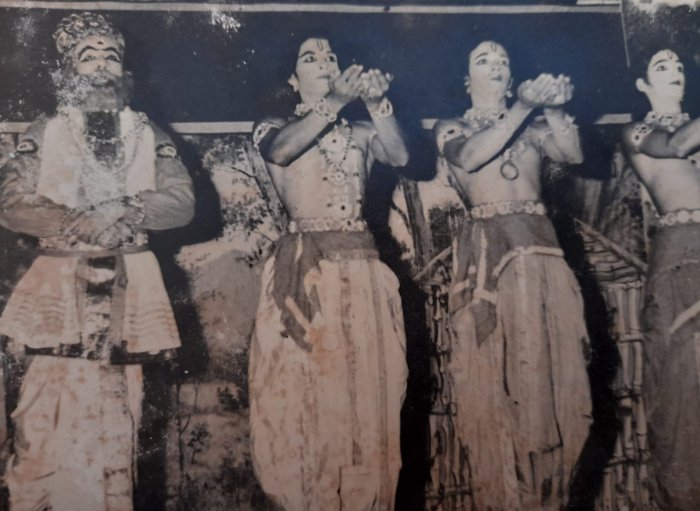 Guru Gopinath in Ramayana What made you enact the roles of Bajrang Bali and Janaka? Sumitra Charat Ram insisted that I should don the roles of Hanuman and Janaka on those particular occasions when the VIPs came. I agreed, in spite of being rather apprehensive. But by the grace of the Almighty, my performance went off satisfactorily. I was convinced that the satisfaction I felt was the blessings of Shri Mookambika Devi. I understand you were employed on contract basis...what developments emerged subsequently? I did the direction of Ram Leela that year on a contract basis. Soon after the program was performed for the first time, I was appointed as the permanent director of Ram Leela on a monthly salary. I started a school called Kerala Kala Kendram in a portion of the Kerala House on Jantar Mantar Road, where I used to take classes after my job at Bharatiya Kala Kendra. Malayalees, Tamilians, Hindi speaking people and Bengali students came to take lessons there. During my stay in Delhi, I got an opportunity to be the Vice President of Delhi Malayalee Association. Raskot Krishnapillai and I raised funds for the Delhi Malayalam school during its initial days. Even though you were so successful, what made you close your Delhi chapter? I realised that my family life was suffering, because I was alone in Delhi, my wife and kids were in Madras and many of my belongings were in Thiruvananthapuram. Also the unbearable extreme climate of Delhi was telling on me. In spite of my hard work I was able to save only Rs.500 after my monthly expenses. So I decided to resign from my job in Bharatiya Kala Kendra, Delhi, and handed over the responsibility of Kerala Kala Kendram to my friend N Sivashankara Menon. At that time he was also the secretary of International Kathakali Center. Before I returned from Delhi to Madras, members of the Delhi Malayalee Association and other well wishers arranged for a send off. Sardar K.M. Panicker, famous newspaper reporter Sivaram etc were a part of that meeting. That day, they gifted me a metal table with creative designs. I am still using that table in my living room. After a few days of reaching Madras, I had an impression that if I start art work in Kerala, the 16 acre land in Thiruvananthapuram would generate a hefty return. After I left for Delhi, Natana Niketanam was reduced to just a board, which I thought would be difficult to revive. 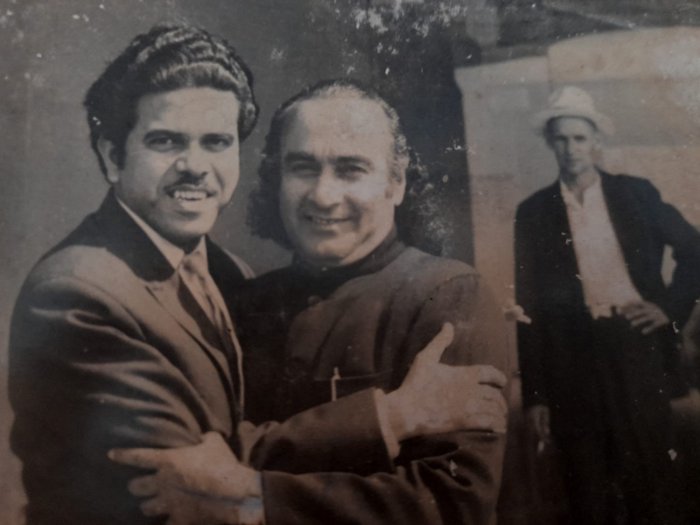 With Sivashankaran in Moscow How did you commence your final settlement in your home state? So once again I was back in Kerala. On 8th July 1961, in the central city of the Kerala state at Ernakulam, 'Vishwa Kala Kendram' was registered according to the rules of The Charitable Society Act by making dignitaries like M.K.K. Nair, Dr. K.N. Pisharody, Respected D. H. Namboodiripad, Balakrishnan Eradi, P Subramaniam, A.N. Thambi, G.P. Shekhar, K.C. Pillai, M.N. Parameshwaran Pillai, Godhavarma Raja, K Narayana Menon, members. The then Chief Minister Pattam Thanu Pillai inaugurated it. Children were taught here for two years and I adapted Ezhuthachhan's Adhyatma Ramayanam into Ramayana ballet. I was deeply involved in directing and performing in it. I framed it in the likeness of the Ram Leela of Delhi. 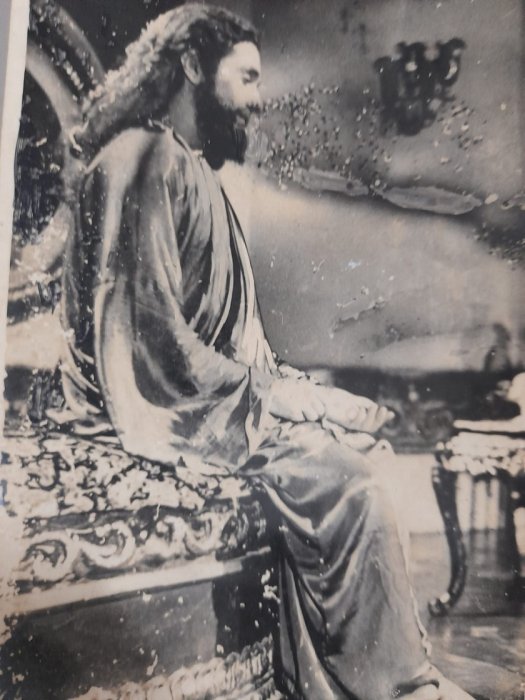 As Jesus Christ in the Malayalam movie 'Jeevitha Nauka' I also directed and performed 'Kerala Vijayam' and 'Yesunatha Charitham'. At the end of two years, I relocated to Vattiyurkkavu in Thiruvananthapuram in Oct 1968. The centre was formally inaugurated by the Mayor of Thiruvananthapuram, C.S. Neelakantan Nair, Director of Education and Dr. Uma Shankar. After coming to Thiruvananthapuram, gradually I built a college with Kalari (practise space) for teaching children. I also got office and hostel rooms constructed. During the time when R Shankar was the Chief Minister of Kerala, Vishwa Kala Kendram received Rs 2000 yearly grant. That amount and the fees that I got from the students were insufficient to run the school. During those times I ended up spending money from my own savings. Initially, the girls and boys were taught for free. Gradually, paying fees was introduced. I designed a syllabus for nritta- nritya-natyam based on my previous experience and started teaching the students based on that syllabus. By the end of March in 1963 after I had rented out the building in Madras, Thangamani and the kids came to stay with me in Thiruvananthapuram. Did you sever all ties with Bharatiya Kala Kendra, New Delhi? At the request of Bharatiya Kala Kendra, I went to Delhi for a month and re-directed the Ram Leela ballet for them. What important event took place during this time? I was awarded the Kendra Sangeet Natak Akademi and the Kerala Sangeet Nataka Academy awards in 1965. In 1959, when I was living in Delhi, I was a member of the General Council of the Central Academy of Music, Dance and Drama. At that time, when the Akademi decided to present me with the Sangeet Natak Akademi Award, I advised them to give it to any other senior and deserving Kathakali artiste in Kerala. This was informed at all-India level and accordingly, the award was given to those who got the highest number of nominations at that stage. In that year, I got 9 nominations, Thekkumkaattil Ravunni Nair got 7, Chengannoor Raman Pillai got 5 nominations. And according to my suggestion, Thekkumkaattil Ravunni Nair was awarded the Central Sangeet Natak Akademi Award. In 1966, I went to Delhi again and stayed at the Bharatiya Kala Kendra for re-directing the Ram Leela. After coming back from Delhi, I directed a 5 hour long Ramayana ballet for a temple festival in 1967 to be performed in Ambalapuzha temple on the occasion of Kodiarchana (one crore archana). The ballet was inaugurated by the then Chief Minister of Kerala, E.M.S. Namboodripad. I told the Chief Minister that I had followed his instructions and had directed the Ramayana ballet which could be understood by all and not only by scholars. He laughed and said, "Well done!" The festival officials were convinced that the Ramayana ballet presented by the Vishwa Kala Kendra would entertain the old and the young alike. So we were able to present this event on 60 other occasions in different temples that year. The following year, we came up with a new ballet called 'Narayaneeyam' and presented it in the Guruvayoor temple. I was awarded the honour of 'Natya Tilakam' and a gold medal was given to me by the Guruvayoor devaswom. We performed Narayaneeyam 48 times in the various temples of Kerala. Ramayana was performed 52 times that year. Later each year, 'Mahabharatam', 'Chandala Bhikshuki', 'Bana Yudham', 'Dakshayagam' were directed as dance dramas though they were not as popular as the Narayaneeyam ballet and Ramayana ballet. After 1971, I did not venture into directing any other new dance ballet. I concentrated on performing the Ramayana ballet at temple festivals year after year. The members of the temple festival committee told me that the crowd which gathers for Ramayanam ballet is huge compared to any other dance-dramas. I am still performing Ramayana ballet every year. Viswa Kala Kendram is getting an amount of Rs.10000 as help from the Government every year.  At the SNA Award ceremony in New Delhi Why did you not accept the third highest civilian award, the Padma Shri? In January 1972, according to the instructions of the Central Government, the CM of Kerala C. Achutha Menon sent the Thiruvananthapuram Collector, C.P. Ramakrishna Pillai, to inform me that the Central Government is thinking of awarding me the Padma Shri. According to custom, only after my approval of acceptance will they publish the news. "I am not interested in receiving the Padma Shri," I said. "Because artistes usually get the Padma Shri two years after they are honoured with a Sangeet Natak Akademi award. I received the SNA award in 1965. My getting the Padma Sri when I am already 64 will not benefit me or my art life in any way." I informed Ramakrishna Pillai to let Achutha Menon know that I am not interested in receiving the Padma Shri. Ramakrishna Pillai went to Delhi and when he was undergoing some administrative training and was put up at the Kerala House when I was also there at that time staying in the outhouse, we conversed with each other almost every day during those three months. He was also the husband of my close friend G.P. Shekhar's daughter Indira. I told him my views on the Padma Shri based on my friendship with him. "Do your work (karma) and take what you get" was my principle. Guruji, I am happy to note that you accepted the D-Litt degree from Rabindra Bharati University, Kolkata. What are some of the other awards you received? On 9th May 1972, I happily went and received the D-Litt degree from Rabindra Bharati University. The awards I received for my dance performances are: 'Abhinava Natarajan' from Bengal Music Conference 'Gurusthanam' from Indian People's Theatre Association 'Natana Kalanidhi' from Akhila Malayalee Association 'Veerashrinkhala and Bangle' from Thiruvithamcore Maharaja 'Natya Tilakam' from Guruvayoor Devaswom 'Kala Ratnam' from Thiruvithamcore Devaswom The kings from the states of Kochi, Mysore, Bikaner, Dholpur, Patiala, Navanagar, Kishangarh gave me Salva and gold coins (Swarna Mudragal). Awards from Kendra Sangeetha Nataka Akademi, Kerala Sangeetha Nataka Academy and Kerala Kalamandalam I was awarded Kirti mudras from Madras Governor, French Governor, Mother of Pondicherry Ashram, Nattor Maharaja, Maharaja Tagore and E.M.S. Namboodripad. Your work experiences have been so varied! Yes, I have served as a palace dancer, manager of Narthakalayam, director of Natana Niketana, director of Bharatiya Kala Kendra ballet, Principal of Kerala Kala Kendram, Classical Indian dance Judge at the 8th World/International Youth Conference held in Helsinki, and adviser of Jaafna School of dance. I have held administrative posts at Madras State Nataka Sangam, Kendra Sangeet Nataka Akademi, Kerala Sangeetha Nataka Academy, Kerala Kalamandalam, Kerala Lalitha Kala Academy and Kunjan Nambiar Memorial Committee. What are some other things that you cherish? Appreciation letters from Mahakavi Vallathol; Universal poet Rabindranath Tagore; famous painter Nandalal Bose; Musicologist, mathematician, writer, mystic Dilip Kumar Roy; Trendsetter in the Arts, O.C. Ganguly; K.S. Ramaswamy Shastri; Madame Maneka; Dr. Cousins; G. Venkatachalam; K.M. Munshi; Sardar K.M. Panicker; Sri Rajamannar; C.R. Reddy; F.W. Thomas; Dr. Pattabhi Seetharamayya; Sir C.P. Ramswamy Iyer; B. Gopala Reddy; C. Rajagopalachari ; Dr. Radhakrishnan; Sri Prakash and Sarojini Naidu. To be continued....  Tapati Chowdhurie trained under Guru Gopinath in Madras and was briefly with International Centre for Kathakali in New Delhi. Presently, she is a freelance writer on the performing arts. Post your comments Please provide your name and email id when you use the Anonymous / blog profiles to post a comment. All appropriate comments posted with name and email id in the blog will be featured in the site. |